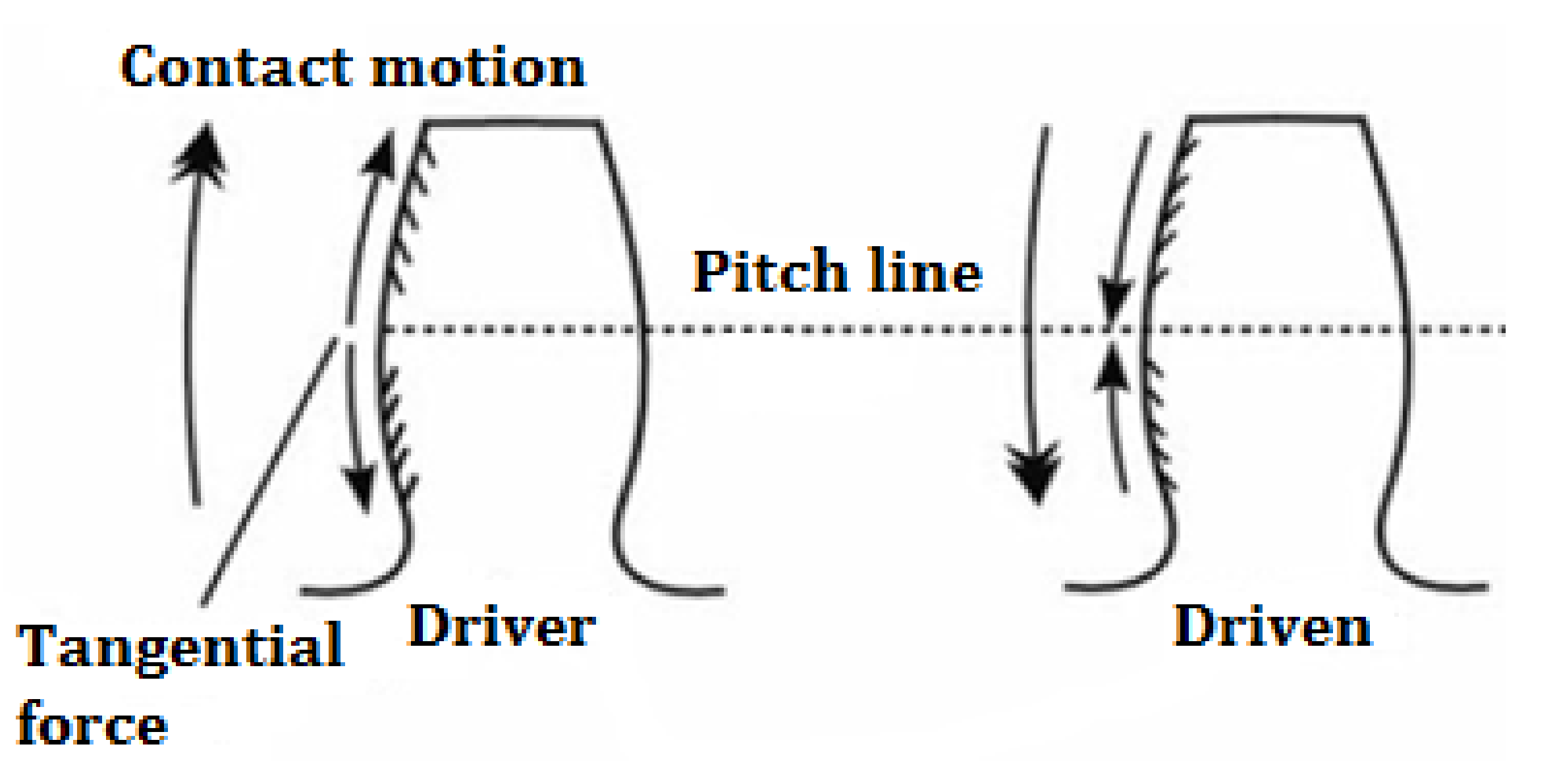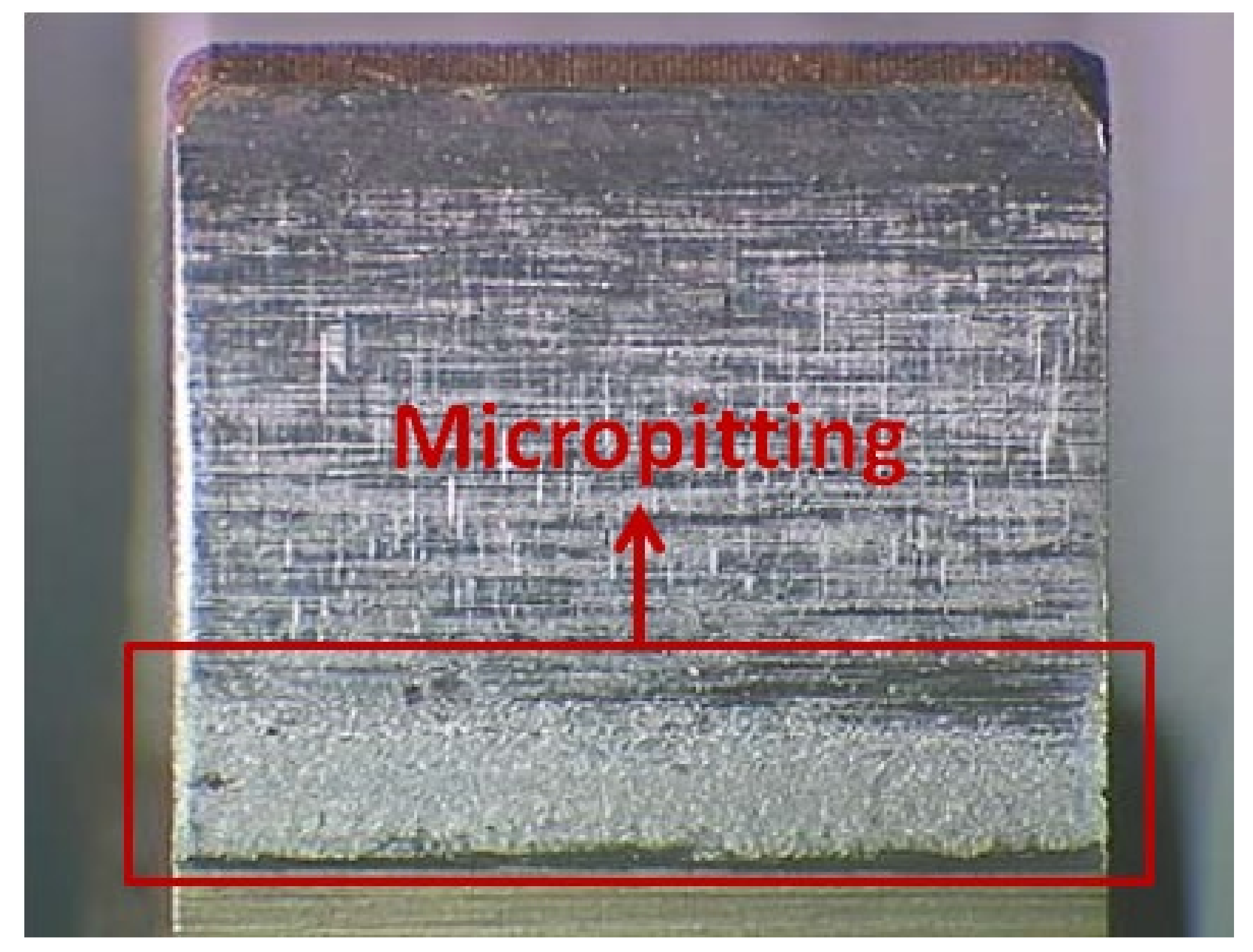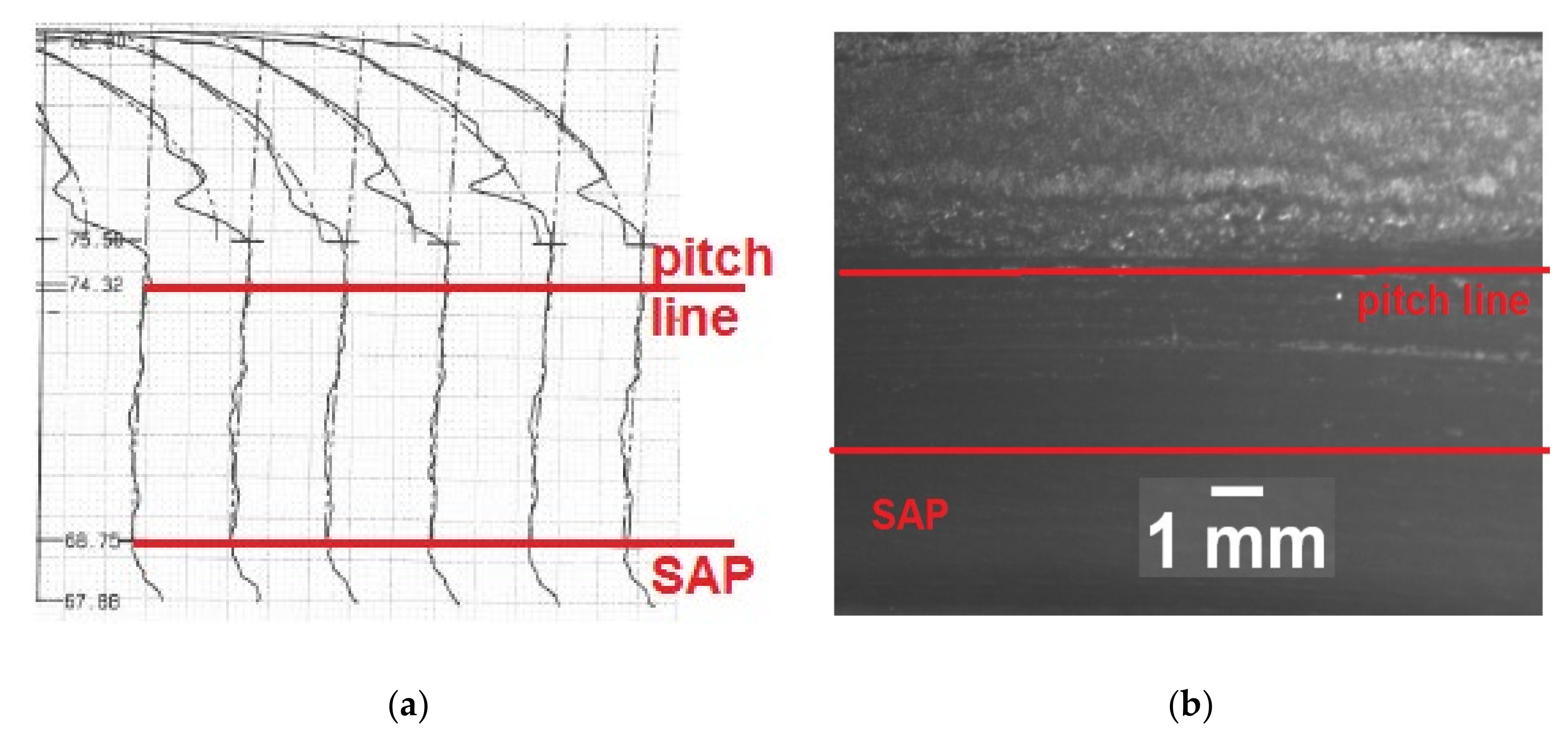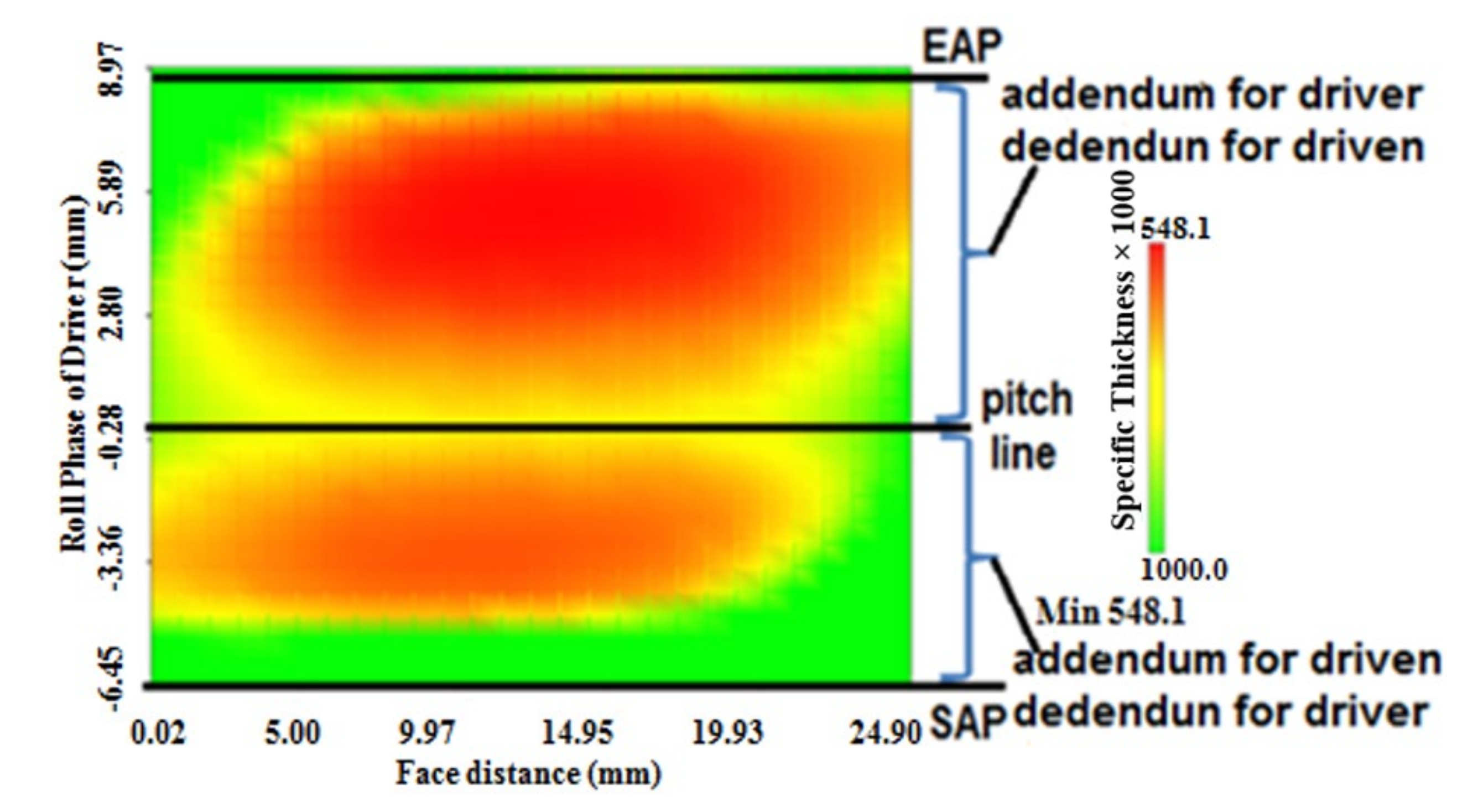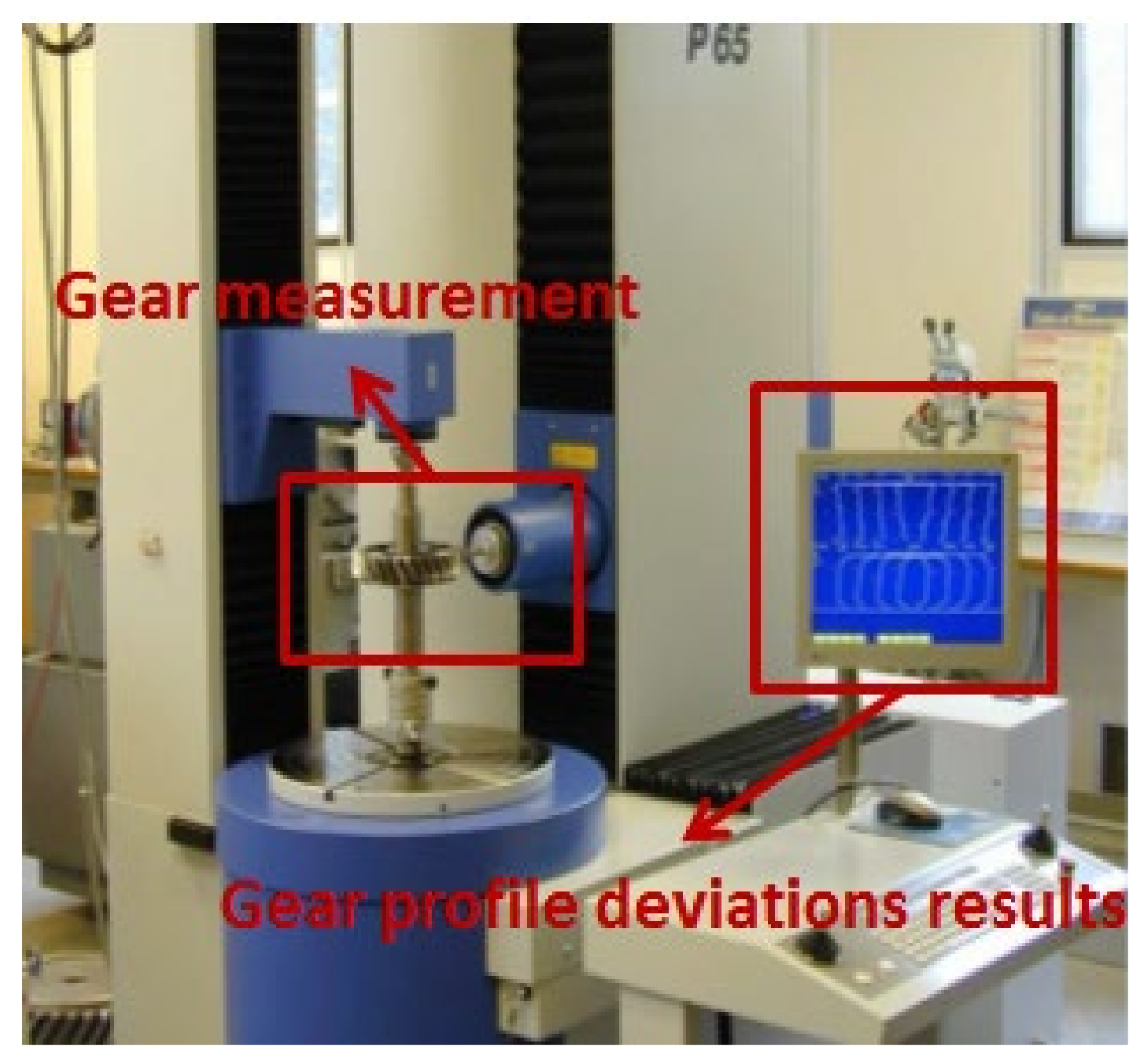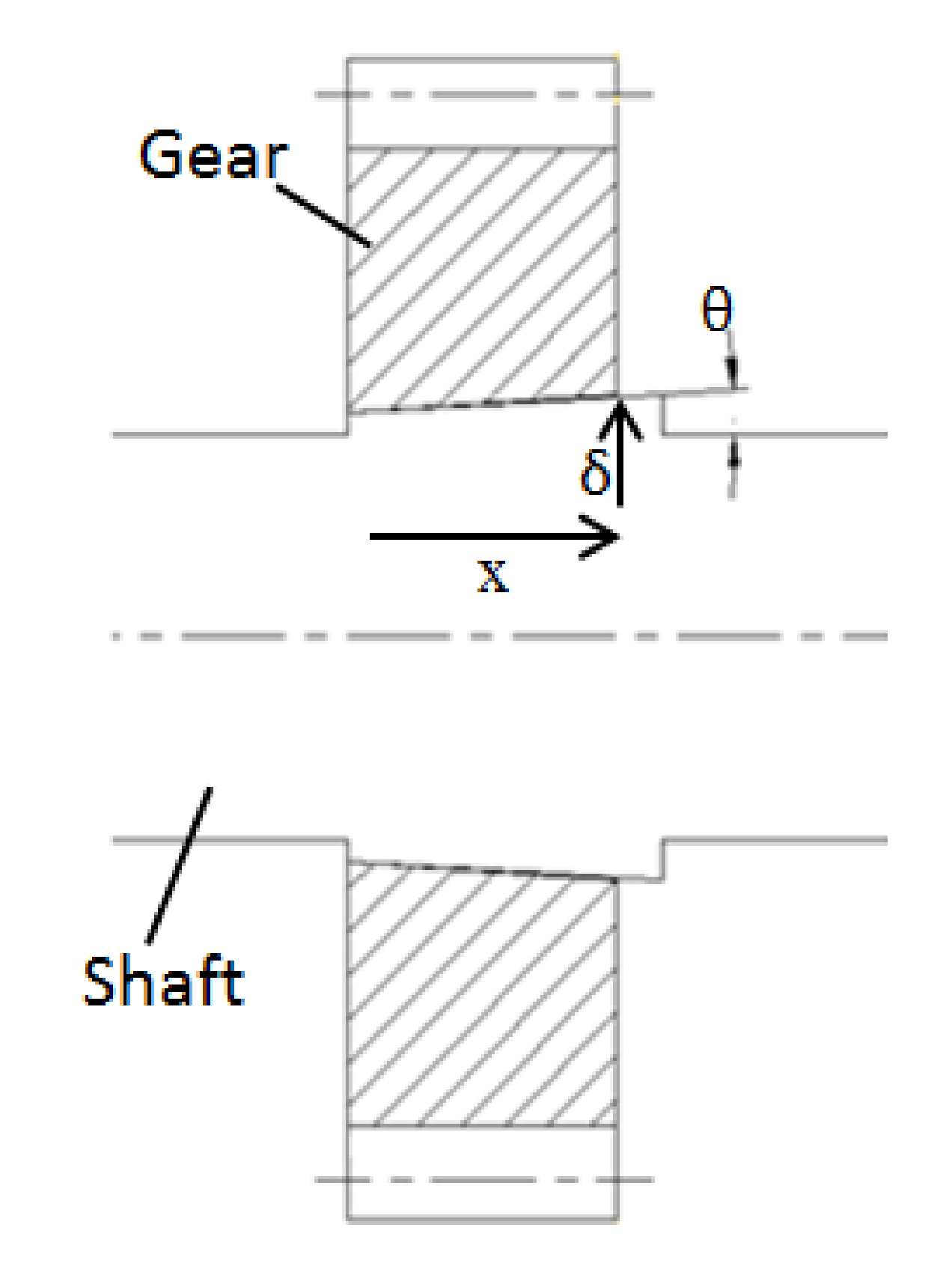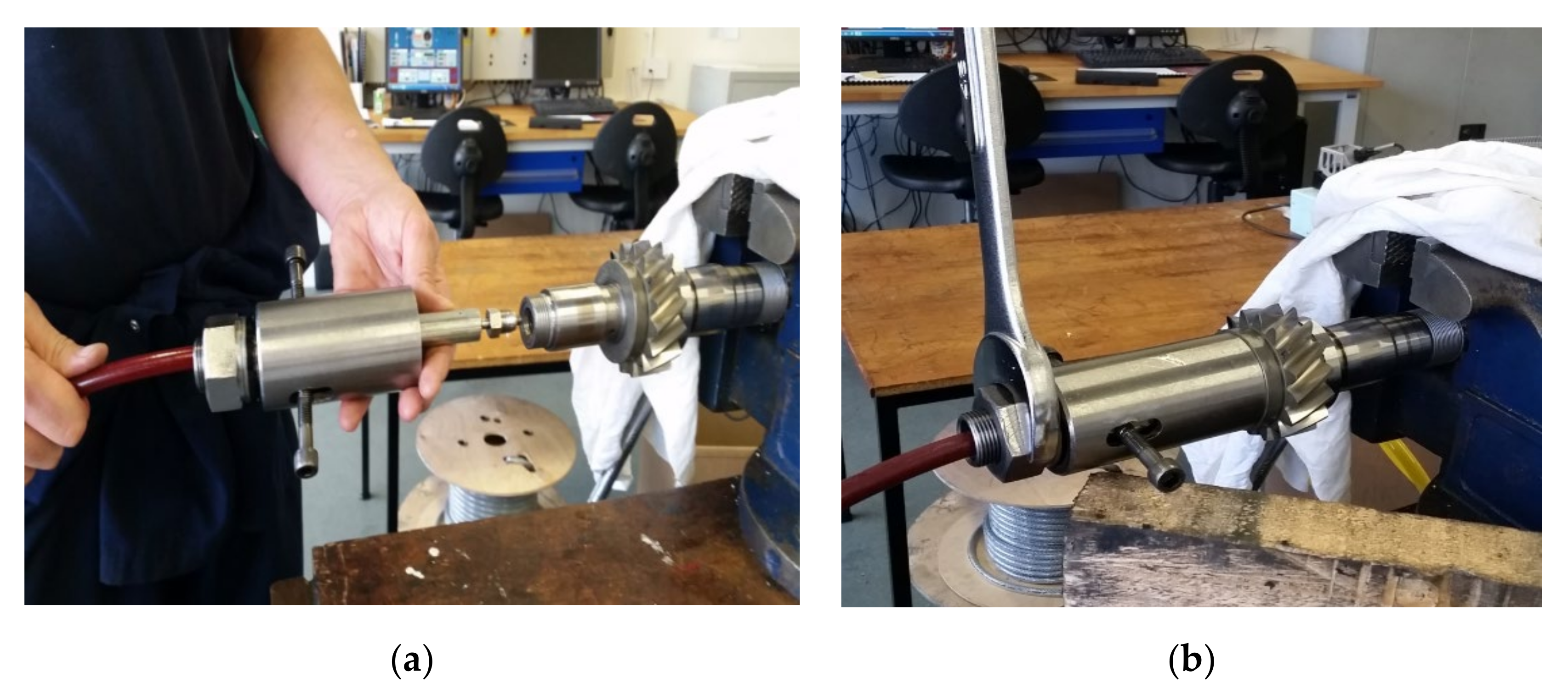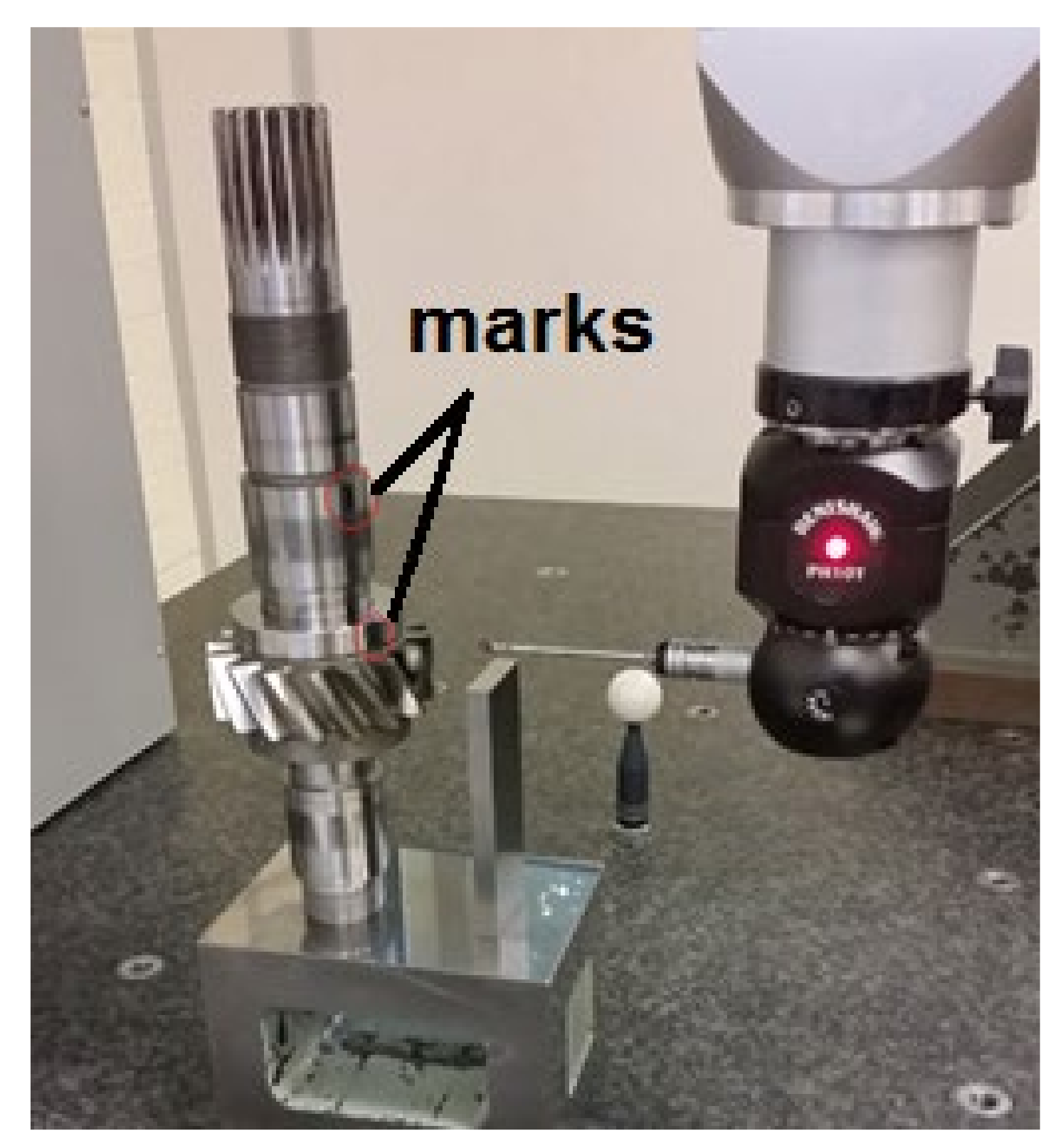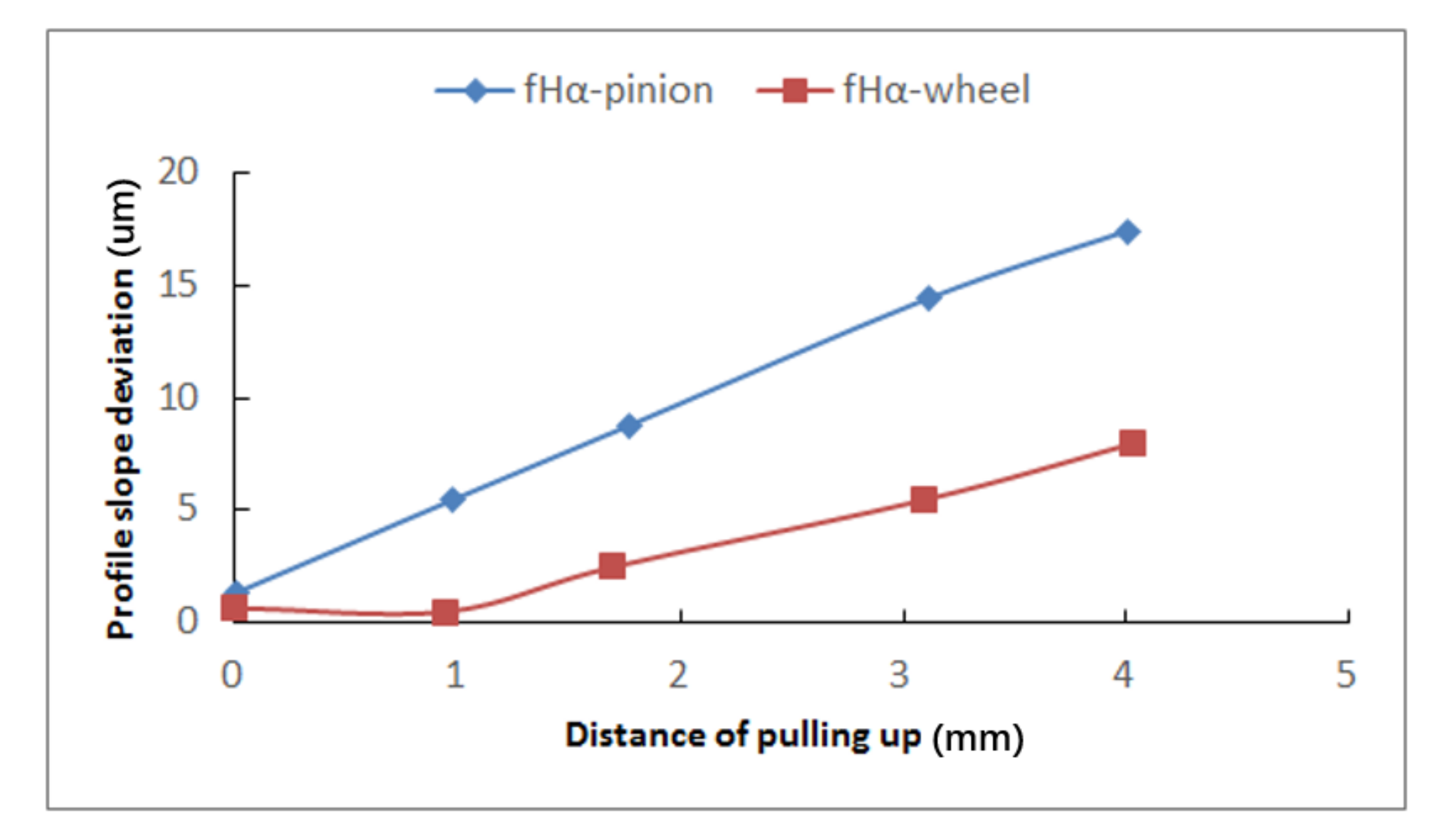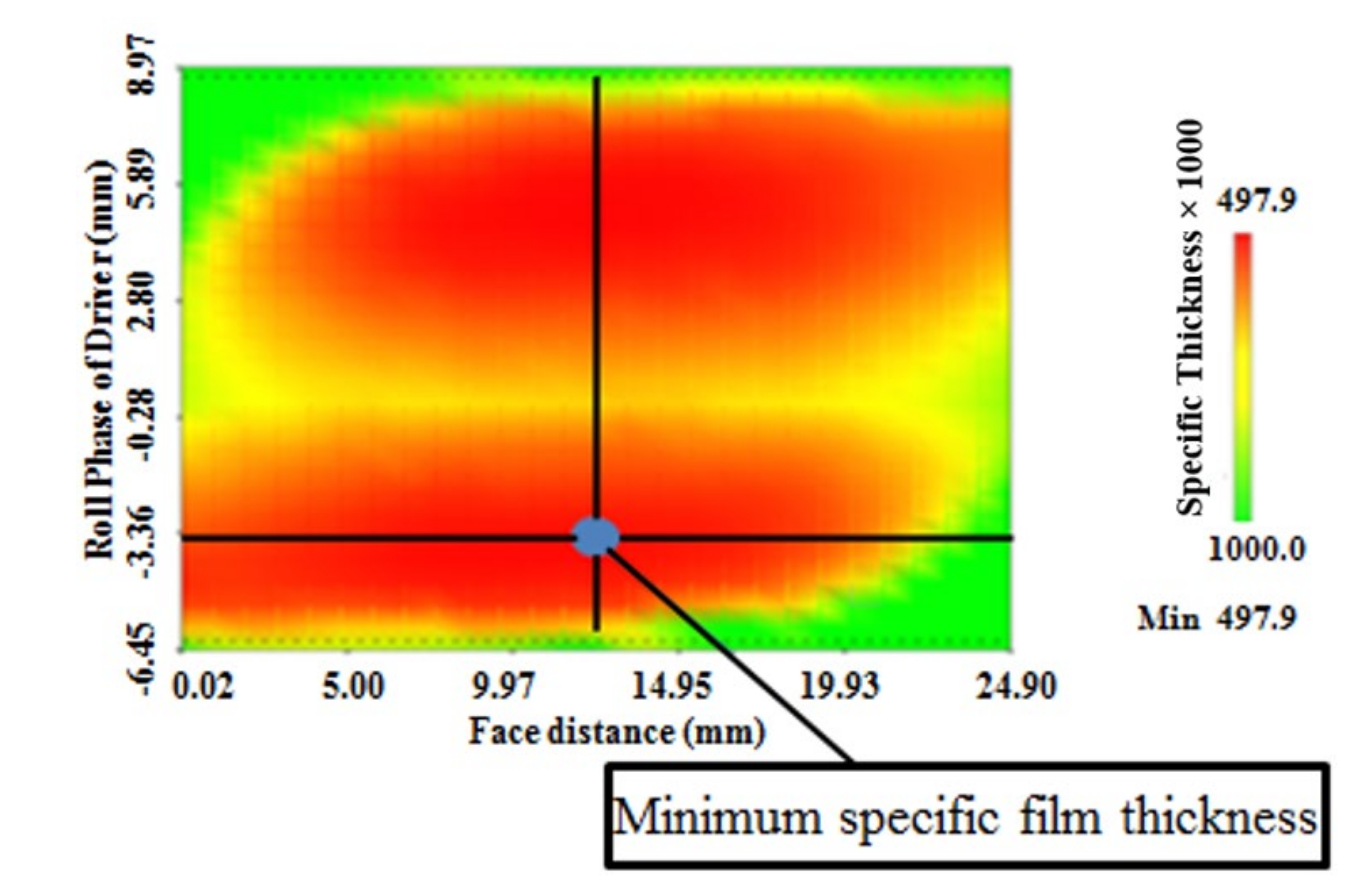1. Introduction
Contact fatigue damage is a common mode of gear failure that is generally manifested as the initiation and progression of micropitting on the flank surface of gear teeth [
1,
2,
3,
4,
5,
6,
7,
8,
9,
10]. Micropitting is a phenomenon that occurs in Hertzian type of rolling and sliding contact that operates in elastohydrodynamic or boundary lubrication regimes [
11,
12]. Micropitting can affect all types of gears, it has been extensively studied by researchers [
13,
14,
15,
16] and is well known to gear designers [
17]. Besides operating conditions such as load, speed, sliding, temperature, surface topography and specific film thickness, the chemical composition of lubrication strongly influences micropitting [
18,
19,
20,
21,
22,
23,
24,
25]. While these parameters are known to affect the performance of micropitting for a gear set, the subject area remains a topic of research. There has been a lot of research done on the impact of surface roughness, load, temperature, hardness and slide to roll ratio on micropitting [
26,
27,
28,
29,
30]. The asperity contact stress between contact surfaces is one of the main reasons to promote micropits [
25,
26]. It is therefore generally considered that micropits can be prevented or lessened by reducing the roughness of the surface. Olver [
30] found that the micropitting level was lessened by increasing the slide to roll ratio (SRR) but the wear rate did not change significantly.
Micropitting is characterized by the presence of fine surface pits and the occurrence of local plastic deformation and shallow surface cracks. Shallow cracks grow against the sliding direction on the gear flank, i.e., towards the pitch point on the driver tooth, and away from the pitch point on the driven tooth as illustrated in
Figure 1. The cracks progress to form micropits which appears as a dull, matte surface to the observer, as shown in
Figure 2.
Micropitting can initiate during running and initial operation and then stop and stabilize. However, if micropitting continues to propagate, it may result in reduced gear tooth accuracy and increasing dynamic loads and noise. Eventually, it can develop into macropitting and other modes of gear failure such as flank-initiated bending fatigue. As a result of this, solutions avoiding micropitting of gear teeth are gaining interest with recent studies including the investigation of improved surface finishes, optimized microgeometry to minimize applied stress, modification of near surface residual stresses and the use of coatings. Zhang [
31] investigated influence of shot-peening and surface finish on the fatigue of gears. A superfinished surface was found to be the most resistant to contact fatigue damage whereas shot peening resulted in a rougher tooth surface and a decreased contact fatigue life. Britton [
32] used a special four-gear rig to determine gear tooth frictional losses and found that superfinishing resulted in a reduction of friction of typically 30 percent with correspondingly lower tooth surface temperatures under the same conditions of load and speed. Frazer [
33] optimized micro-geometry to minimize applied stress for low friction losses. Moorthy [
34] found that both BALINITs C and Nb–Scoated gears showed enhanced resistance to micro-pitting damage by removing localized stress concentration at microvalleys present on as ground gears.
Micropitting has become a particular problem in the gear surface fatigue area over the last 20 years. Remarkable developments in micropitting studies have been achieved recently by many researchers and engineers on both theoretical and experimental fields. Large amounts of investigations are yet to be further launched to thoroughly understand the micropitting mechanism. Morales Espejel [
35] studied the occurrence of micropitting damage in gear teeth contacts. In his study, an existing general micropitting model which accounts for mixed lubrication conditions, stress history and fatigue damage accumulation, was adapted to deal with the transient contact conditions that exist during gear teeth meshing. The model considered the concurrent effects of surface fatigue and mild wear on the evolution of tooth surface roughness and therefore captured the complexities of damage accumulation on tooth flanks in a more realistic manner than hitherto possible. Clarke [
36] made progress towards an understanding of the basic mechanism of micropitting in gears based on analysis of the contact mechanics and elastohydrodynamic lubrication (EHL) of gear tooth surfaces under realistic operating conditions. Results are presented which demonstrate the crucial influence of EHL film thickness in relation to roughness on predicted contact and near-surface fatigue. Hohn [
37] studied the effects of lubricant temperature, circumferential speed and tooth flank roughness, and showed major influences on the micropitting resistance of gear wheels. The lubrication film thickness and the surface roughness were found to be dominant parameters. The chemical characteristics of the lubricant, i.e., the base oil and its additives, are also important factors. However, currently there is no standard evaluation for determining micropitting risk although ISO TR 15144-1 [
11] provides guidance on minimum film thickness, linking this to micropitting risk. The prediction of micropitting remains a challenging problem and needs to be investigated further.
It was demonstrated [
38] that the location of micropitting is close to the surface near the root of the teeth (dedendum). Brandão [
39] developed a numerical model of surface-initiated failures and then verified it by applying an actual micropitting test on the carburized gears [
40]. The results clearly showed that micropitting could be observed between the pitch line region and the tooth root after the loading period. Winkelmann [
41] showed that the most common type of micropitting was wear and it mostly occurred in dedendum. However, authors found for some test gears connected with shafts by tapered hole interference fit (the gear geometry is shown in
Table 1) in the Design Unit, Newcastle University, micropitting on the pinion occurs at the addendum (the tip region) as shown in
Figure 3.
From
Figure 3a, we can see that the biggest profile deviation used to represent micropitting occurs above pitch line (addendum). It can be seen from
Figure 3b that the micropitting damage (the dull and grey part) is above the pitch line (addendum), which is very different from the usual phenomenon (micropitting in the root region), shown in
Figure 2.
This study attempted to find the reason of micropitting occurring at addendum using an experimentally validated 3D–TCA method—Gear Analysis for Transmission Error and Stress (GATES) [
42] based on ISO/TR 15144-1 [
11] to predict the micropitting and tried to understand the key influences likely to affect micropitting location.
2. Prediction of Micropitting
Micropitting is a very complicated surface fatigue and involves material, lubrication, speed, load, temperature, surface roughness, etc. Currently, there is no standard for determining micropitting. However, some methods attempt to predict micropitting. ISO/TR 15144-1:2014 [
11] is one of the methods and provides principles for calculation of micropitting load capacity of cylindrical involute spur and helical gears with external teeth. The basis for the calculation of the micropitting load capacity of a gear set is the model of the minimum operating specific lubricant film thickness in the contact zone. Although the calculation of specific lubricant film thickness does not provide a direct method for assessing micropitting load capacity, it can serve as an evaluation criterion when applied as part of a suitable comparative procedure based on known gear performance.
In ISO/TR 15144-1:2014, the calculation of micropitting load capacity is based on the local specific film thickness λ
GF,Y in the contact zone and the permissible specific film thickness λ
GFP. To account for micropitting load capacity, the safety factor S
λ according to Equation (1) is defined [
11]:
It is assumed that micropitting can occur when the safety factor is less than the minimum required safety factor. For the determination of the safety factor S
λ, the minimum specific film thickness has to be obtained from Equation (2):
where:
where:
The symbols are explained in the nomenclature section. There are no standard values for permissible specific film thickness. The determination of the permissible specific film thickness needs lots of experimental investigations and careful comparative studies, so it is very hard to obtain the exact permissible specific film thickness. Usually we just calculate the specific film thickness. Although the calculation of specific film thickness does not provide a direct method for assessing micropitting risk, it can serve as an evaluation criterion of comparative analysis.
In this study, we just calculate the specific film thickness to do some comparative analysis using GATES, an experimentally validated 3D–TCA method. This TCA method is based on ISO/TR 15144-1:2014 [
11], using a full 3D FEA stiffness model to estimate the gear stiffness as the 1st stage and a 2nd stage tooth contact analysis to estimate the specific film thickness and other functional parameters. Its primary advantage is to predict specific film thickness by applying manufacturing deviations and specifying micro geometry corrections to consistent with the actual state of gears.
The procedures to calculate specific film thickness in GATES are as follows:
- (1)
Define the gear macro geometry, including tooth number, module, pressure angle, helix angle, face width, profile shift coefficient, tip diameter, root diameter and etc.
- (2)
Input rating parameters, including material data, duty cycle, quality and roughness, application data, misalignment, lubrication and etc.
- (3)
Input additional micropitting data, including lubricant viscosity at 40 °C and 100 °C, lubricant density at 15 °C, lubricant inlet temperature, lubricant method and etc. which are required in ISO/TR 15144-1:2014 [
11].
- (4)
Check micropitting report in the theoretical analysis package Dontyne.
- (5)
Run GATES-TCA to check some results related with micropitting including sliding velocity, contact temperature and specific film thickness.
A specific film thickness result determined by GATES is shown in
Figure 4. From
Figure 4, we can see that the
X-axis represents gear’s facewidth,
Y-axis represents the roll phase of driver, different colors represent different value of specific film thickness, the deepest red indicates the minimum specific film thickness. The area between SAP and pitch line of driver symbolizes the dedendum of driver and addendum of driven. The area between pitch line and EAP of driver symbolizes the addendum of driver and dedendum of driven. We can clearly see the amount and distribution of specific film thickness from GATES-3D result contour. We will use it to do the later comparative analysis.
3. Measurement Procedures
In order to find the reason of micropitting problem mentioned above, we did some tests of gears with all known parameters in the Design Unit, Newcastle University.
Before test, we measured the gears on a Klingelnberg P65 gear measuring machine (produced by Klingelnberg Co. Ltd., Ettlingen, Germany) that uses an involute generation measurement method to measure gear profile form deviations (
Figure 5) to record the original profile/lead deviation and other parameters.
The test gears and shafts are connected by interference fit connection of their conical surface. Before test, gears must be pulled up on shaft to ensure accurate location and enough interference between gear bore and shaft must be guaranteed to transfer torque. The relationship between the distances of pulling up (x) and interference (δ) shown in
Figure 6 is given by the following expression:
where θ is the angle of taper, tanθ = 1/60 for the test gears.
In order to ensure that the connection of gear and shaft still has good tightness after multiple assembly and disassembly operations, the assembly and disassembly of gear with interference fit connection of conical surface adopts the hydraulic method, that is, injecting high-pressure oil between the mating surfaces, so as to increase the outer diameter of the hub housing and reduce the inner diameter of the shaft, it makes assembly and disassembly of the gear easily and also reduces the scratching on the mating surface. When using this method, it is necessary to open oil holes and grooves on the wheel hub, and special disassembly tools such as high-pressure oil pump, axial propeller, etc.
The procedures of pulling up gear on shaft showed in
Figure 7 are as follows:
- (1)
Clean the assembly joint surface of gear and shaft with clean lubricating oil.
- (2)
Put the gear set on the shaft, turn it gently by hand, and push it up at the same time.
- (3)
Press the axial propulsion piston of the axial propeller into the guide cylinder, and then install the axial propeller on the shaft, and the axial propulsion piston can contact with the hub.
- (4)
Connect the oil pump and the pipeline to the shaft and the axial propeller, respectively.
- (5)
Start the high-pressure oil pump, inject oil into the oil hole on the shaft first, and then close the oil return valve after reaching a certain oil pressure to keep the oil pressure unchanged. The oil pressure value can be determined by GB/T 15755-1995 [
43].
- (6)
Then, oil is injected into the axial thruster, and the axial propulsion piston pops out and the gear is pushed in. The distance of gear moving axially is the distance of pulling up.
- (7)
Open the return valve of the high-pressure oil pump; release the oil pressure of the high-pressure oil pump after releasing the oil pressure on the shaft.
- (8)
After installation, remove the oil injection pipeline and axial thruster.
The steps of pulling out gears with interference fit connection of conical surface are as follows:
- (1)
In order to prevent the hub from popping out and damaging the parts, install the axial propeller on the shaft first, and leave a certain clearance between the hub and the axial press in device
- (2)
Connect the oil filling pipeline of the high-pressure oil pump to the oil filling hole of the shaft, and inject oil to a certain oil pressure (which can be determined by GB/T 15755-1995 [
43]), and the rear wheel will pop out automatically
- (3)
Remove the oil injection pipeline and axial compressor.
To ensure the exact distance of pulling up are known, we measured the position of gears on shaft using an Endeavor 122010 coordinate measuring machine (CMM) (produced by Sheffield Company, Ruskin, FL, USA, and its measurement resolution is 0.1 μm) before and after pulling up. The measurement process is shown in
Figure 8.
To make sure we measure the same location of gears, we made some marks on the gear hub and shaft as shown in
Figure 8. After pulling up, we measured the gears on the Klingelnberg P65 gear measuring machine again to record the change of profile /lead deviation and other parameters.
